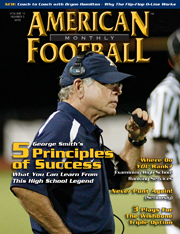Article CategoriesAFM Magazine
|
No Punting Allowedby: Rex LardnerEditor American Football Monthly © More from this issue The controversy began last November 16th when New England Coach Bill Belichick went for a fourth down conversion late in a game from deep in his own territory against the Indianapolis Colts. With 2:08 left and the Colts with only one timeout, a successful conversion, in all probability, would have won the game. Belichick felt – from his own research – that the Patriots had a 60% chance of making the fourth and two for a first down. The Patriots were stopped short, the Colts took over, scored a touchdown, and ultimately won the game, 35-34. Should the Pats have punted in this situation?
Subscribe today!
|
|
|||||||
| HOME |
MAGAZINE |
SUBSCRIBE | ONLINE COLUMNISTS | COACHING VIDEOS |
Copyright 2025, AmericanFootballMonthly.com
All Rights Reserved





